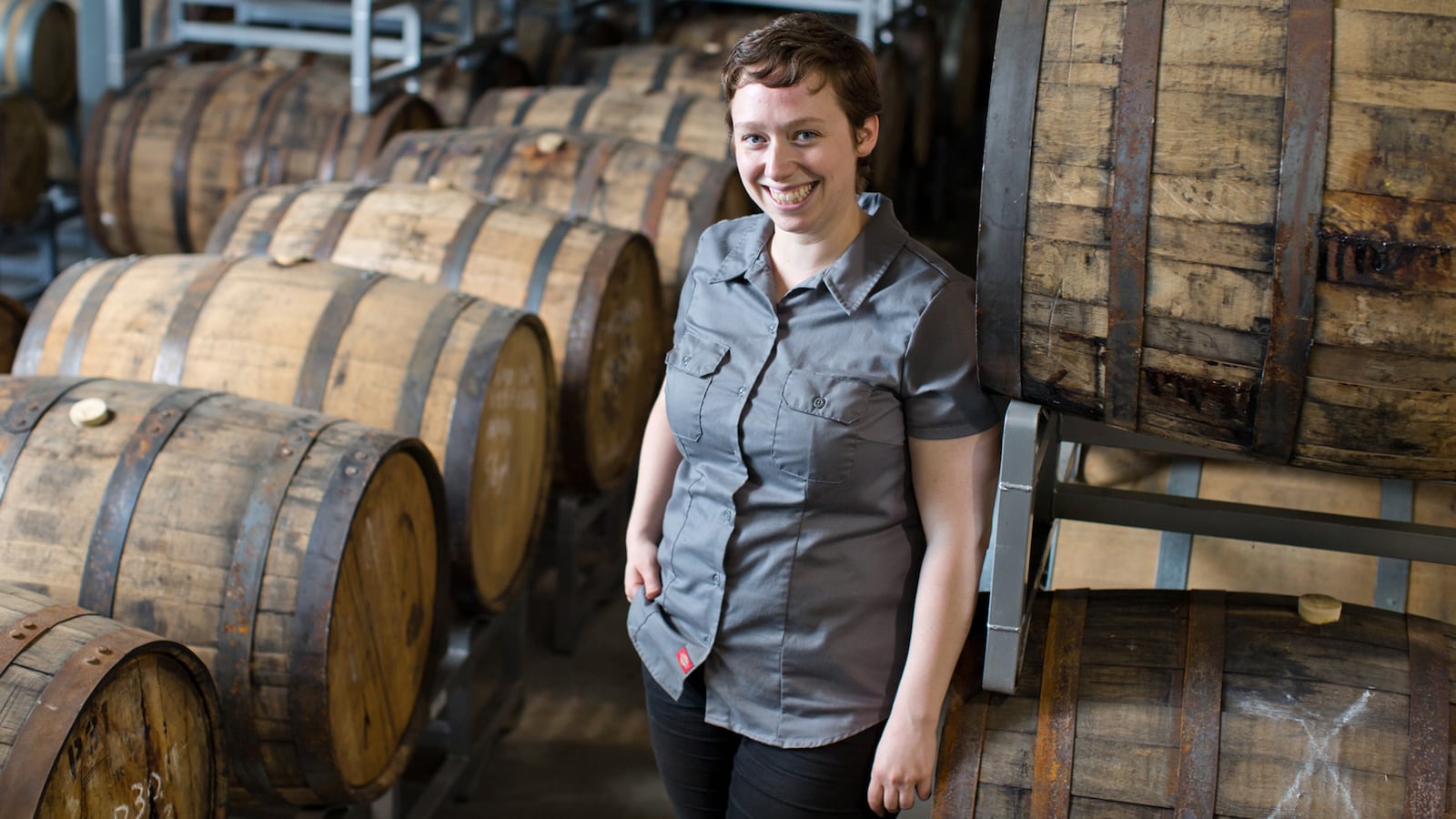Spirits lovers this week got a long-overdue chance to taste something unavailable for decades: rum that’s been bottled-in-bond. Privateer Rum in Ipswich, Massachusetts, released its Navy Yard Bottled-in-Bond Rum on April 21—apparently the first bonded rum on the market since the 1950s.
Yes, I know, you’re thinking, woo? A bonded-rum sounds like something chiefly of interest to antiquarians—akin to a soda cracker made with an extra helping of tartar.
The return of bonded rum is admittedly a small flag on a low hill—one scarcely visible amid the clamor of the greater spirits marketplace. But from this hill something interesting is visible—a slow embrace of an antique term to guarantee authenticity. And it’s positioned to make a lasting impression in an era of “craft” spirits flimflam and fakery.
“It revives the conversation about what are you making, and who made it,” says Maggie Campbell, distiller and president of Privateer.
So what exactly is a bonded spirit? Basically, it’s the love child of distillers and the federal government. To more fully understand this, some history is in order.
Bonded warehouses have been around for centuries. These were warehouses established as small principalities within or contiguous to the distillery grounds, where the gates were literally controlled by a government officer. Warehouse doors often had two locks; one key was held by the distillery, and the other by the revenuer. Nothing could go in or out of this fief without a scrupulous logging of liquids.
These conditions offered an advantage: instead of paying taxes on liquor as it came off the still, distillers could squire their untaxed newmake off to this special warehouse, where it would sit unmolested by revenuers until it departed the warehouse for distribution. Of course, with its release the tax bill would come due. Think of bonding as an IRA for liquor. (These were also popular with distillers because their long-term tax liability gradually declined as the angel’s share took a portion of each cask through evaporation.)
That was all fine and well until the late 19th century. At the time, the nation was inundated with a flood of faux booze. Well, real booze but with fake flavor. This all began in the middle 1800s when a cadre of American rectifiers realized that they could boost profits by buying cheap neutral spirits in bulk, and then flavoring it with sketchy ingredients to taste sort-of-like whiskey, rum, gin or whatever. (Often these flavoring agents were extremely deleterious to your health, like creosote and pelargonic ether.)
An entire industry arose around sort-of-like spirits. Among the more notable instruction manuals was Pierre Lacour’s The Manufacture of Liquors, Wines, and Cordials Without the Aid of Distillation, published in 1853. The French-born New Orleans author was forthright if nothing else: “The great secret of success in the manufacture of liquors,” he wrote, “consists in imparting to the imitation the precise aroma of the genuine, and thus obtain an article of spirit as near reality as possible, at a far less cost.”
Lacour listed recipes to make Jamaican rum, various gins, and “Old Bourbon,” “Monangahela,” and “Old Roanoke,” whiskies. His approach generally involved blending straight ethanol with matter, such as beets, turpentine, oil of cloves, oak bark (“red and black oak are best”), “bone black” (made from the burned bones of animals) and ammonia, which would cure the “groggy” aroma in fresh spirits—although rectifiers were cautioned to not add so much ammonia that it “would indicate its own presence.”
Unsurprisingly, distillers who took pride in making and aging their own liquor disliked competing with charlatans and forgers. Among these folks was Colonel E.H. Taylor, who headed up the OFC Distillery in Frankfort, Kentucky. (Today it’s Buffalo Trace.) He understood that consumers were increasingly mistrustful about what went into their bottle of booze, which affected OFC and like-minded honest distillers. So they sought a reputable referee who could guarantee purity and authenticity—that the taste of charred oak came from a cask, and not from turpentine, wintergreen, and bone black.
The best referee, this group concluded, was the U.S. government. Taylor and others started lobbying Congress in 1893, which led to the Bottled in Bond Act of 1897—one of the first federal consumer protection laws. The act allowed distillers to bottle spirits directly from their bonded warehouses under government supervision. After which the corked bottles would be affixed with a tamper-proof paper engraved seal, stating it met the criteria of being “bottled in bond.”
These criteria included a lot of asterisks of scant interest to the general consumer—the spirit had to made by a single distiller during a single distilling season, it had to be aged in wood for at least four years, and it had to be bottled at exactly 100-proof. But what was of interest to the consumer was that the bottle contained what the label promised: an unadulterated spirit.
To be fair, some respected distillers, including Isaac Wolfe Bernheim, founder of I. W. Harper and namesake of Bernheim Original Wheat Whiskey, rightly argued that blending was also an art—as it continues to be today by many makers of Cognac and Scotch whisky. Legitimate blended spirits couldn’t be bottled in bond, which may explain in part why the craft of blending is not as revered on this side of the Atlantic today.
While the act was never meant to guarantee quality—only production protocols—in short order it became a hallmark of top-shelf liquor, with producers crowing about their bottled-in-bond offerings. Park & Tilford whiskey featured “Bottled in Bond” in all-capital letters nearly as large as their name. “When a guest asks for a ‘bonded’ bourbon,” read a Park & Tilford ad in 1905, “here is a magnificent Kentucky whiskey sure to win his applause.”
While whiskey was the spirit most commonly associated with bonded liquor, other bonded spirits also appeared. “A purer rum than Felton’s can’t be made,” boasted Felton’s Crystal Springs Rum, made in Boston. “The Government seal on the bottle attests its absolute purity.”
Bottled-in-bond production continued after the pause of Prohibition, but the name gradually lost its luster. Inexperienced drinkers didn’t really know what it meant; it became a curiosity and feral designation, like the Good Housekeeping Seal of Approval. Bonded liquor migrated to the bottom shelf, where hoary standbys like Old Grandad and Old Forester maintained a barely discernible pulse.
Then came the American whiskey revival, beginning about two decades ago. A new generation of educated spirit consumers sprouted like corn in June, and distillers began to dust off their bottled-in-bond expressions and returned them to higher shelves. Since last fall, Early Times and Old Overholt Rye have re-released bonded versions of their whiskies. And Laird’s venerable bottled-in-bond apple brandy, which had been quietly dropped four years ago because of booming demand and hardships in fulfilling the “single season” requirement, started the trip to the shelves again this April. “You should begin to see it back in the market in several months,” says Lisa Laird Dunn, executive vice president at Laird & Company.
Yet the warmest embrace of bonded liquor may soon come in the booming craft spirits world, which has already started to take note. Over the past decade, a simmering debate has persisted among craft distillers over the term “craft.” Those who ferment and distill their own alcohol grumble that modern-day rectifiers were simply buying neutral grain spirits and filtering and flavoring it, or buying whiskey made by industrial producers and blending or barrel-finishing it before claiming the liquor to be local “craft.” (Sometimes framed as the “fakers vs. makers” debate.) While nobody these days is flavoring with creosote or bone black—the 1906 Pure Food and Drug Act more comprehensively regulated what we ingest—in the debate over what’s legitimate you can hear echoes of the 1890s.
When it comes to defining craft, about the only thing everyone agrees on is that no one will ever agree on it—it’s an elusive and slippery term, and the definition will remain fluid for foreseeable future.
But that’s not the case with “bottled-in-bond.” It’s a warranty to the consumer that it’s “made here, bottled here.” As the feds decree under the act, “the label shall bear the real name of the distillery or the trade name under which the distillery produced and warehoused the spirits, and the plant (or registered distillery) number in which produced; and the plant number in which bottled.”
While a distiller who chooses to label a spirit as bonded must clear some vexing hurdles—aging four years; bottling at 100-proof; maintaining paperwork to ensure single-season distilling—it offers a stamp of authenticity, with a side of dusty heritage.
Among the smaller whiskey distillers now offering a bottled-in-bond version of their spirit are Laws Whiskey House, Kings County Distillery, Old Pogue Distillery, Tom’s Foolery Distillery, Wigle Whiskey, Spirits Works Distillery, and Dad’s Hat.
Although whiskey currently dominates the “bonded” designation, as it has historically, it’s open to all sprit categories. (One can even sell a bonded vodka, although the code stipulates that storage containers must be “metal, glass, porcelain or paraffin-lined.”)
“I want everyone to know we did the work,” says Maggie Campbell of her newly released Navy Yard Bottled-in-Bond Rum. She notes that the rum category in particular is rife with bulk rums repackaged to look as if locally produced

Privateer’s Bottled-in-Bond Navy Yard is the fifteenth in their “Distiller’s Drawer” series of limited releases. In this case, Campbell found one barrel of their Navy Yard rum that was maturing with more complexity than the others, and squirreled it away to ensure that it remained untapped for four years. From it, they’ve produced 234 bottles, available at the distillery only for $80.
Yes, that’s just a few drops amid the flood of spirits being produced today. But expect a rivulet to grow as more patient craft producers find themselves with stocks aged at least four years. Reaching back to a law from 1897 may prove the best way to tout authenticity, as well as position themselves for the future.






